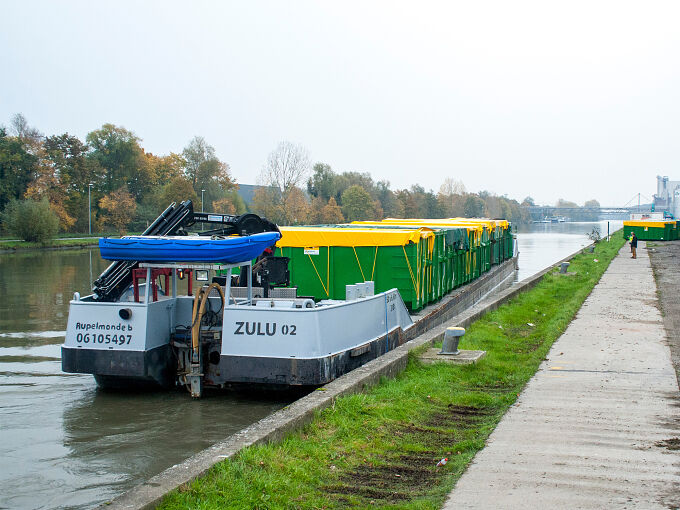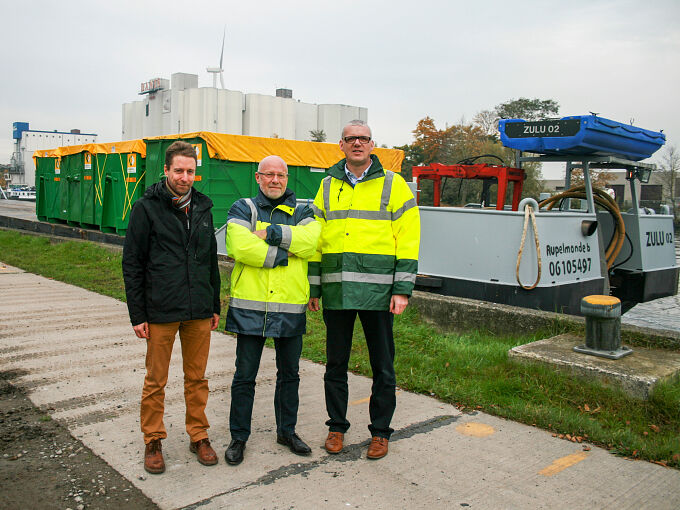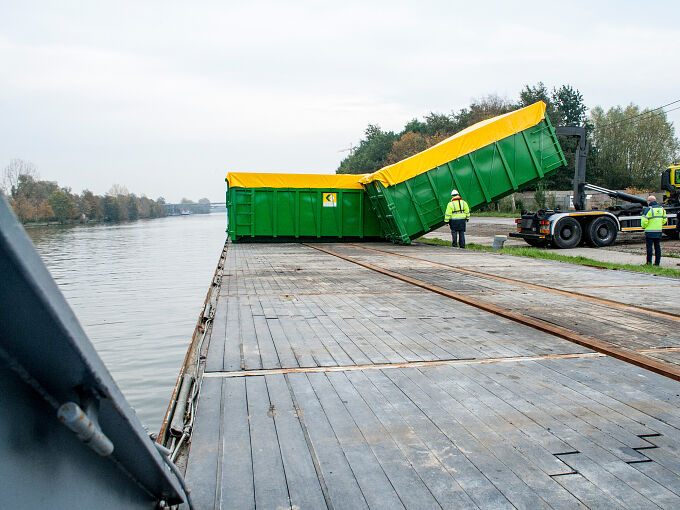Sustainability comes first in everything we do. This includes transportation by road, which is the source of most of our CO2 emissions. Moreover, our drivers grapple with traffic jams on our overfull roads every single day – reason enough for us to seek out alternative methods of transportation.
The number of waste processing companies operating in Belgium is fairly limited. We and our competitors often move our material streams along the same routes at the same times, and although our country is small, drivers spend a considerable number of hours driving back and forth across it. Furthermore, the various waste collectors do not always operate in balance: some have too much of a particular stream while others have too little. We could reduce road kilometres significantly by bundling these transport streams. Often enough, the biggest expense for businesses comes in the ‘last mile’, or the last phase of transportation before products reach their final destination. Shifting transport streams to inland waterways could also result in great savings.
“The decision to move towards transportation by water emerged from a desire for sustainability and a need to take pressure off of Antwerp’s ring road. So many of our drivers are fed up with traffic jams. We wanted to address this problem, and at the same time serve as an example to other companies,” says Koen Smits, Area Manager at Vanheede.
Vanheede, partner in the Flanders Recycling Hub
Belgium is a leader in recycling and has a wealth of knowledge and experience in dealing with waste. With the Flanders Recycling Hub project, the Flemish Institute for Logistics (Vlaams Instituut voor de Logistiek - VIL), the Public Waste Agency of Flanders (Openbare Vlaamse Afvalstoffenmaatschappij - OVAM) and the Flemish Institute for Technological Research (Vlaamse Instelling voor Technologisch Onderzoek - VITO) aim to make Flanders an international hub for the streams of waste materials flowing into and out of the region. Vanheede joins 26 other Flemish companies in this project.
In 2016 we invested in a water-based site in the Antwerp harbour whose location ensures us of direct links to other provinces and countries via road, rail and water. In cooperation with the VIL, we set up a test project for waste transportation via inland shipping routes in order to discover opportunities for expansion. The outcome will serve as a basis for a plan of action.
Test project: transporting waste via inland water routes
Transporting waste over water is not new – but our innovative approach to it is new. We are not simply shifting waste in bulk, but moving separate dumpsters filled with sorted waste coming directly from our customers’ sites. Uniquely, our trucks can load and empty dumpsters on and from the ships, a development that reduces the investment required.
The test project began on the second Monday of November with the departure of our ship, Zulu 02, from the Antwerp harbour towards Limburg to pick up materials bound for processing plants in West Flanders. The load consisted of jute sacks for Derotex in Wielsbeke, untreated wood going to Unilin in Wielsbeke, and metal destined for Galloo in Menen. On Wednesday the ship stopped at the Izegem harbour, where 13 dumpsters measuring 30m³ each were offloaded and sent on to their final destinations. Our time-lapse film shows the entire process in a single, compact minute.
Multimodal transport: our vision for the future
“Our intention for the future is to have a shuttle service continually going back and forth, and to allow other companies to make use of it. We have calculated that with a single ship going back and forth on the route all week, Vanheede Environment Group can reduce its road transports by 4,000 per year. If other companies that currently move waste and recycling materials by road to West Flanders, Limburg and Antwerp follow our example, that could easily result in 76,000 fewer trucks on our roads,” explains Koen Smits, Area Manager at Vanheede.
The ship used in the test project is not the vessel we will use in the future. That one will need to be 2m wider than the one we have now so that it can carry our largest dumpsters, which measure 40m³. We would also prefer to use a longer ship that can carry 30 dumpsters at once – a maximum load for maximum impact.
Challenges include the height of the quays, the water level and, of course, truck access to quaysides. A ship at the quayside must be at ground level so that a hooklift truck can pull the dumpsters up. Moreover, the ground needs to be fairly well paved for trucks to approach the quaysides without problems. We have entered into talks with the Antwerp Harbour Manager and Provincial Development company (Provinciale Ontwikkelingsmaatschappij – POM) to address these issues.
Today, a driver might spend an entire day taking a load from Limburg to West Flanders – but a ship could move 13 dumpsters in one trip. We are proud to be working on sustainable transport developments such as this. Our ambition is to expand our efforts further and make our transports as multi-modal as possible.



